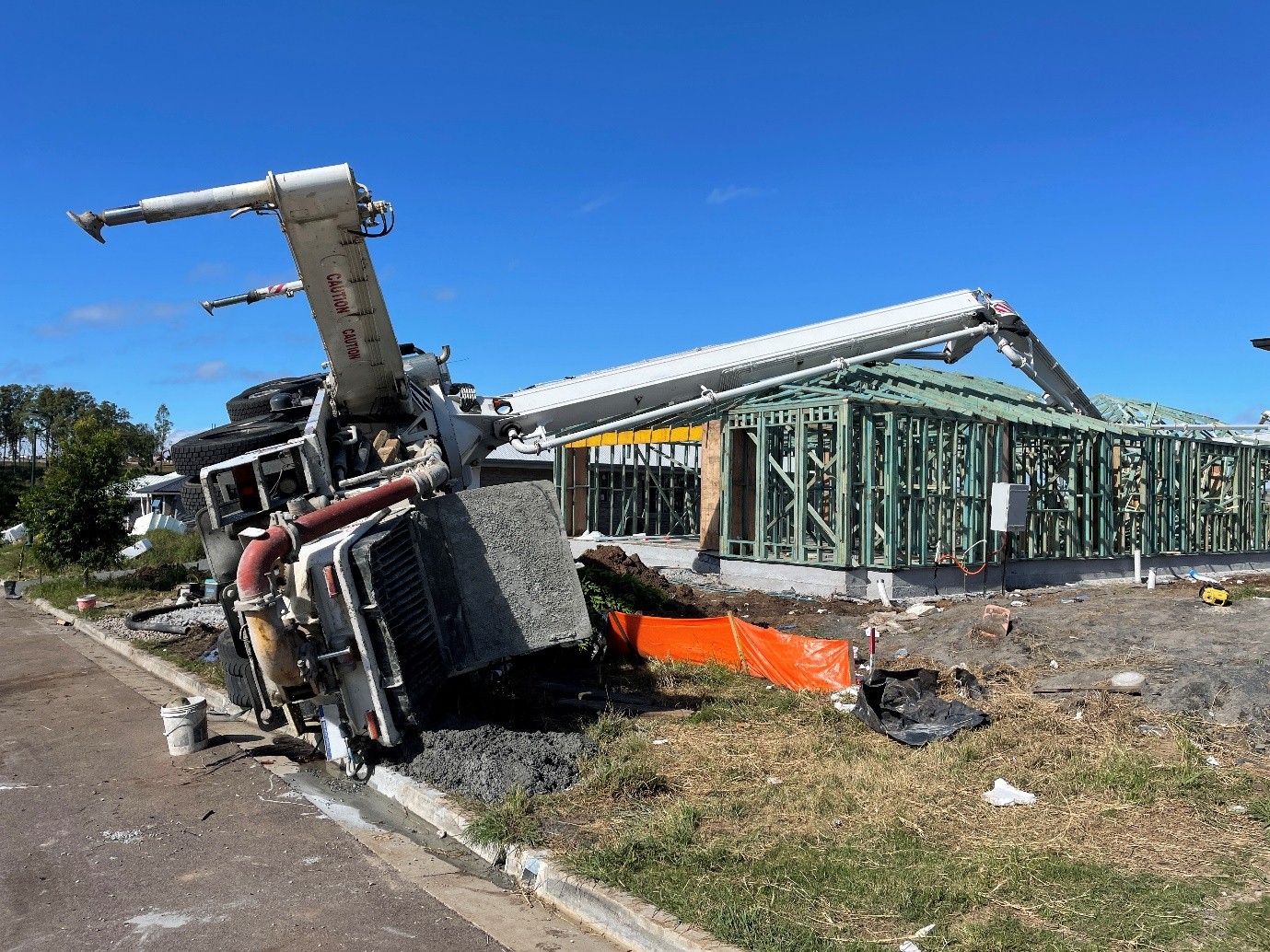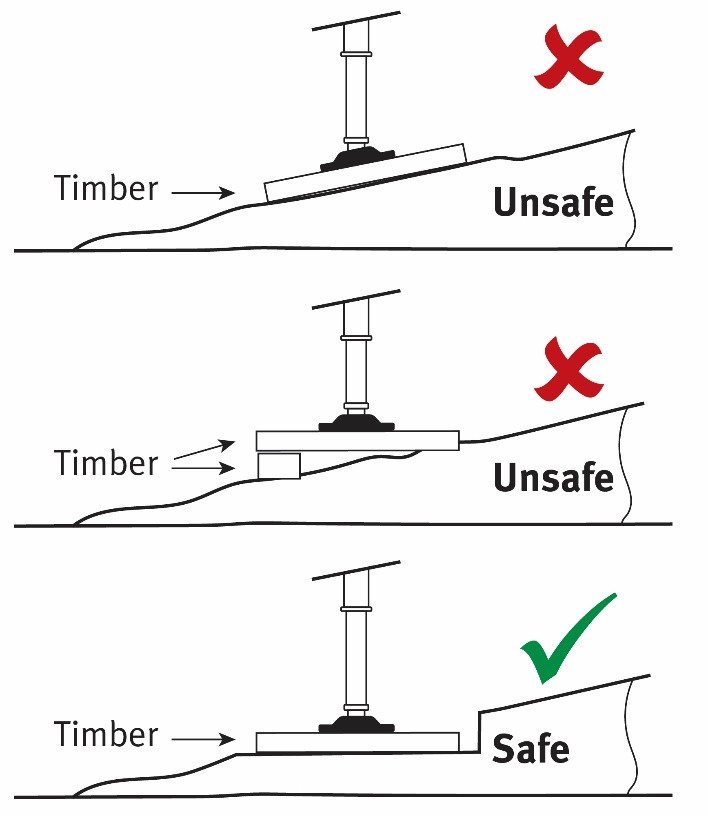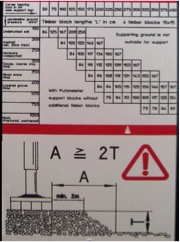Mobile concrete placing boom overturn incidents
In December 2021, a concreter suffered serious injuries including a cervical spinal fracture and lacerations to his head and body after being struck by a mobile concrete placing boom at a residential construction site. The concreter was part of a team pouring a house slab.
Early investigations indicate one of the mobile concrete pump’s outriggers moved off its dunnage while operating, sinking into the adjacent ground. This appears to have resulted in the concrete pump’s boom moving in an uncontrolled manner, striking the concreter.
There were two more incidents in March 2022 where mobile concrete placing booms overturned. Fortunately, there were no injuries but there was significant damage to both buildings and plant.
Investigations are continuing.
Figure 1 shows one of the overturned mobile concrete placing booms.

Figure 1: overturned mobile concrete placing boom.
These findings are not yet confirmed, and investigations are continuing into the exact cause.
Safety issues
There are numerous risks associated with the setting-up of concrete pumping equipment, including mobile concrete pumping booms tipping over and the risk of workers being crushed or run over by the mobile concrete pump itself.
Ground conditions can vary dramatically from one workplace to another, and even within a sit itself over time. Saturated earth will dramatically reduce the bearing capacity of the ground. Failure to address poor ground conditions may cause the plant to overturn and result in serious injury to the concrete pump operator and other people nearby. Factors that affect the ground providing adequate support include:
- water, including when it is mixed with the soil as mud, and where it is present under the surface
- the type of ground (clay, sand, rock or a mixture of these)
- back-filled ground that was previously an excavation or trench
- cavities or penetrations that have been covered but still exist
- continued operation of the concrete pump in one location
- ground slope reduces stability and can also cause the concrete pump to move off supports during use.
Ways to manage health and safety
Taking steps to manage risks is a condition of doing business in Queensland. Effective risk management starts with a commitment to health and safety from those who manage the business. If an incident occurs, you'll need to show the regulator that you’ve used an effective risk management process. This responsibility is covered by your primary duty of care in the Work Health and Safety Act 2011.
Use the hierarchy of controls to help decide how to eliminate and reduce risks in your place of work. The hierarchy of controls ranks types of control methods from the highest level of protection and reliability to the lowest. It’s a step-by-step approach to eliminating or reducing risks. You must work through the hierarchy of controls when managing risks, with the aim of eliminating the hazard, which is the most effective control.
Possible control measures to prevent similar incidents
The Work Health and Safety Regulation 2011 includes specific duties for persons conducting a business or undertaking (PCBUs) with management or control of a construction workplace, plant, powered mobile plant and plant that lifts or suspends loads. If you own concrete pumping plant, you are the person with management or control of that plant and have duties to eliminate or minimise the risks associated with the plant.
Planning and preparation of site
Planning for concrete pumping operations should start as early as possible in the development of any work or project to help eliminate many of the associated health and safety risks. Consultation with all people engaged in the work including the principal contractor, the concrete pumping PCBU, electricity entity, designer and project manager is essential.
Some issues to be considered when planning for concrete pumping operations include:
- proximity to overhead powerlines
- concrete pumping requirements (including concrete pump selection, concrete delivery and site access) at the project design stage
- ensuring an emergency plan has been prepared for each workplace where concrete pumping work will be done
- use of additional safety observers depending on the size and complexity of the work.
- assessment of ground support capacity and slope
- ensure enough space is provided to avoid short legging the outriggers - short legging is a practice that should be avoided wherever practicable due to the increased risk of overturning the mobile plant.
The Concrete pumping code of practice 2019 (PDF, 1.04 MB) outlines the roles and responsibilities associated with concrete pumping operations including:
- concrete pump owner - one of the concrete pump owner’s responsibilities is to ensure pads and/or timbers supplied with the concrete pumping equipment will adequately support the plant (the owner may need to seek the advice of a competent person when selecting appropriate materials to support the outrigger feet)
- concrete pumping equipment operator - before and during concrete pumping operations, the concrete pump operator must in addition to other requirements:
- complete the daily inspection checklist, including filling out the logbook
- for mobile concrete placing booms, outriggers should be set according to the manufacturer’s operating instructions for the specific type of mobile concrete pump
- monitor the safe use of the concrete pump, concrete delivery lines and boom
- in the case of mobile concrete placing booms, monitor the safe support of the carrier, including observing outrigger pads and the ground
- be in view of the line hand and monitor the safe delivery of concrete.
Ground conditions
When setting-up a concrete pump, the area should be level, capable of supporting the load and free of obstructions, with careful attention paid to the following:
- precautions should be taken when a concrete pump is used in the vicinity of an excavation, the concrete pump should not be positioned over or adjacent to:
- previously disturbed ground that’s been back-filled
- excavations, trenches or holes in the ground
- cellars, basements or pits
- inadequately compacted or soft ground.
- if the ground is near an excavation, the pump operator should immediately refer the matter to the principal contractor for re-location to a more stable location
- when the concrete pump is continuously operated in one location, ensure the ground has not compacted to the extent that the concrete pump is more likely to overturn
- the pump unit is set up level, and if this is not possible, ensure the incline or angle of the machine does not exceed the manufacturer’s recommendations (refer to operating instruction manual)
- when setting up close to concrete pads/pavement, be aware the ground could be softer due to rain water run-off and/or the ground being disturbed.
Outriggers
- supply members (e.g. timbers) that have a large enough area and won’t flex as packing under the outrigger base plates
- ensure the outriggers pads are clear of excavations, soft or filled ground, or other obstacles liable to interfere with the safe operation of the machine
- ensure the members (e.g. timbers) have sufficient bearing area to support the machine
- ensure the outriggers do not subside, by making regular checks of stability
- timbers, pads and steel plate should be of dimensions and materials as specified by the concrete pump manufacturer (if the manufacturer has not provided this information, a competent person such as an engineer, should specify the minimum size of the material to be used)
- when setting up outrigger timbers on sloping ground, cut into the ground and set the timbers up so they are level. Don’t lay the timbers on sloping ground as the outrigger feet can slide off the timbers. Don’t bridge the timbers over timbers underneath as this increases the bearing load on the ground (refer Figure 2)
- ensure outriggers are set up in accordance with the plant manufacturer’s instructions (for one example see Figure 3).

Figure 2: Methods of outrigger base plate support

Figure 3: Example of a decal provided by one manufacturer, Putzmeister, as an operator aid.
Source: Concrete Pumping Code of Practice 2019
Ground pressure and outrigger pad area
The ground bearing capacity must be greater than the maximum pressure applied by the mobile plant to the ground to ensure the plant does not sink and/or overturn. If not, then appropriate control measures, such as increasing the area of the outrigger pads or carrying out earthworks to increase the ground’s bearing capacity are to be implemented.
Some concrete placing boom manufacturers provide information on the maximum force applied by outriggers and the minimum area of outrigger pads to be used. Further guidance on ground bearing capacities can be found in section 4.2.2.4 of the Concrete pumping code of practice 2019 (PDF, 1.04 MB).
Information, training instruction and PPE
Information, training instruction or supervision for concrete pumping operations should include but not limited to:
- the method for inspection and maintenance of concrete pumping equipment
- knowledge of the manufacturer's operation and service manuals
- the work methods to be used in the setting up and safe operation of concrete placement booms and pumps
- the correct use, care and storage of tools and equipment to be used, including electrical safety practices.
Supervisors must:
- ensure only those workers who have received training and instruction are authorised to carry out that work
- monitor the work sufficiently to make sure safe work practices are being carried out, including the use of all protection systems and personal protection equipment.
The following items of PPE are required when pumping concrete:
- safety helmets
- eye protection
- safety vest
- rubber safety boots.
The control measures put in place should be reviewed regularly to make sure they work as planned.
More information
- Concrete pumping Code of Practice 2019 (PDF, 1.04 MB)
- Safe support of mobile plant guide (PDF, 3.42 MB)
- Support of mobile plant on outriggers – alert
- Mobile concrete placing boom stability – alert
- Concrete pumping
Support for people affected by a serious workplace incident
For advice and support: